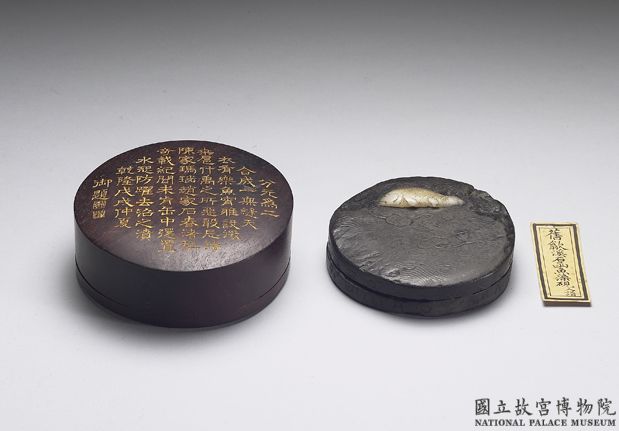She-stone inkstone with fish and aquatic plants decoration, Ming dynasty (1368-1644)
- Image Number: K1F000557N000000000PAB
- Dynasty: Ming dynasty
- Category: Studio implements
- Function: Stationery
- Material: Minerals/Jade Jewelry/She Stone
- Description:
The Western Qing Inkstone Manual says, “Shexi Stone Letter Fish and Algae Inkstone”, while in “Eight Complete Works of Imperial Poems and Prose of Emperor Gaozong of the Qing Dynasty, four volumes of imperial poems, volume 50, and pages 20-21, it says,” Chanting the old end stream Stone Letter Fish and Algae Inkstone “, but in terms of real objects, it seems to be Duanxi Stone. This Inkstone is a natural stone, slightly trimmed into a round shape, and the ink receiving part is only slightly polished into a round shape. The surrounding ring has carving marks. The ink is carved in the shape of a fish, and the cover of the Inkstone is inlaid with a jade fish, Corresponding to the form of the inkstone pool, the cover is full of waves and floating algae patterns, and the inkstone and the cover seam. Inkstone inscriptions in seal script are engraved around the edge: “Fish with algae can be attributed to the water pipe, and there is a stone king in the city who can get light from Wensi”. Twenty characters, and then part of the characters, are indistinct. The back of the inkstone is engraved with a poem written by the Emperor Gaozong of the Qing Dynasty. The regular script reads: “The elements are divided into two into one. There are fish in the sky without sewing. The Xiaoya set up a levy on Sanghushi, and Yu dared to forget his evil deeds.”. “Chen’s agate, Zhao Jiashi, and Chunzhu are said to have recorded a wonderful story, but they did not want to put water in the Fou, fearing that they would jump to cure it.”. The title of the article is “The Emperor Qianlong was stationed in 1898 in the mid summer”, and the second seal is “Bi De” and “Lang Run”. According to this poem, it was made in 1778 AD in the 43rd year of Emperor Qianlong, Emperor Gaozong of the Qing Dynasty. At the same time, it is also recorded in the Eighth Complete Collection of Imperial Poems and Essays of Emperor Gaozong of the Qing Dynasty, and the Fourth Complete Collection of Imperial Poems, Volume 50, Page 20-21.

![图片[2]-She-stone inkstone with fish and aquatic plants decoration, Ming dynasty (1368-1644)-China Archive](https://chinaarchive.net/Ming dynasty/Studio implements/K1F000557N000000000PAB-45631.jpg)
![图片[3]-She-stone inkstone with fish and aquatic plants decoration, Ming dynasty (1368-1644)-China Archive](https://chinaarchive.net/Ming dynasty/Studio implements/K1F000557N000000000PAB-45632.jpg)
Pictures & Images [HD] download
© Copyright
The copyright of the article belongs to the author, please keep the original link for reprinting.
THE END





